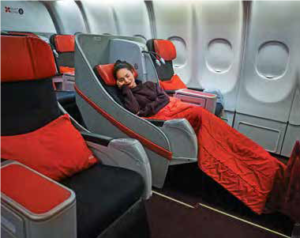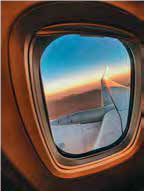Captain Lim Khoy Hing shares insights on choosing seats and handling
turbulence on board – for a relaxing journey through the skies.

Source Travel 3Sixty
Some say it’s the aisle seat, while others prefer to sit by the window so they can enjoy the sights. There are also those who feel nothing beats First Class while others think that the best seats are in the cockpit!

Source Travel 3sixty
Widow seat with best view
In reality, it depends on various factors. If you’re travelling long haul with a two-hour transit between connecting flights – for example, from London to Kuala Lumpur via Dubai – then, it’s a good idea to opt for a seat near the exit. Dubai International is one of the world’s busiest airports and although it seems that two hours is ample time for a transit, every minute saved counts towards minimizing your travel stress.
Strategic Selection
Tall passengers, in general, enjoy the bulkhead seats – these are the ones situated directly behind the wall, where the absence of reclining seats in front allow for more legroom.
And, if you are particularly averse to turbulence, choose a seat nearest to the center of gravity (CG) of the plane, which is generally close to the wings. Similar to a seesaw, the fulcrum near the CG is less prone to movement compared to the front and rear of the aircraft.
Just as there are choice seats, there are less than desirable ones as well. The middle seats in any row are least preferred, mostly because no one has yet figured out who legitimately ‘owns’ the armrest! Also, seats near the flight attendants and the lavatories are not particularly a prime pick as these areas become noisy and crowded at times.
Overall, the seats that are most comfortable are the ones in First Class or the Premium Flatbeds on AirAsia’s Airbus 330 aircraft. Passengers here enjoy a comparatively quiet environment, and have the added advantage of being the first to board and disembark.

Source Travel 3Sixty
Airbus A380 provides a smoother ride
Big is Better
When it comes to comfort in air travel, size does matter, and there is a distinct difference between flying on a big aircraft and a smaller one.
The comparison between an ocean liner and a smaller boat, like a tugboat, provides a good analogy. I was recently on a 90,000-tonne cruise liner, which sailed smoothly even through turbulent waters. In contrast, I would imagine that a tugboat travelling the same rough seas would be tossed about.
To understand this analogy better, we can examine Newton’s Law of Motion on inertia. It takes more force to jiggle or displace a heavier object than it does a smaller one. The same principle applies to a plane in flight.
These days, most airplanes like the Airbus A350 or A380, and the Boeing 787, are equipped with an ‘anti-turbulence device’.
Essentially, the sensors in this device can detect if the aircraft has been given a ‘kick’ and can instantly react by moving the flight control to counter the turbulence.

Source Travel 3Sixty
Morning flights are generally smoother
Unpredictable Bumps
Turbulence can feel like you’re on a rollercoaster ride, and can jolt even the most seasoned of travelers. However, if your seat belt is securely fastened, there’s nothing to worry about, as turbulence is more a matter of discomfort than safety.
I have flown with forecasted heavy turbulence, which turned out to be mild. Then, there were times when a light forecast of turbulence turned out to be a very uncomfortable experience. The truth is, forecasting turbulence is not an exact science.
In practice, the best guide for pilots with regards to turbulence often comes from the aircraft flying ahead that is cruising at the same level. Based on the report of the plane in front, a pilot can change altitude to avoid turbulent conditions.
It should be noted that it is highly unlikely that very severe turbulence can cause damage to aircraft. Today’s modern airliners are designed and tested to withstand far more turbulence than most people would ever experience. The Boeing 787, for instance, is built with wings that are designed to flex.
Take Heart

Source Travel 3Sixty
Fasten your seat belts securely – a precaution of sudden turbulence
There are many factors that contribute to flying conditions, and whether or not your flight encounters turbulence.
Broadly speaking, it is best to choose a flight that departs early in the day instead of in the afternoon. This is because the afternoon sun can cause uneven heating of the Earth’s surface, resulting in turbulent conditions. However, from a practical point of view, it is not plausible that you always travel on a flight that departs in the morning as there are other considerations like your budget and flight availability.
So, the next time you encounter turbulence mid-air, strap in and take a deep breath. If you like riding roller-coasters, enjoy the experience! If not, close your eyes, relax and take comfort in the fact that your captain knows what he or she is doing.
With that, I wish you a safe and smooth journey
Posted: 01.06.19